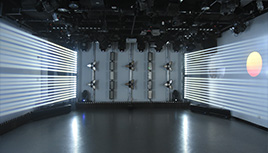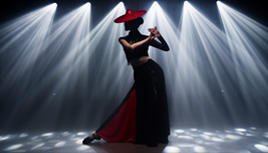The Importance of Color Temperature in Stage Lighting Design
2025-02-08 Post By: Longmangroup
Color temperature is a crucial factor in stage lighting design that is often overlooked. It refers to the color appearance of a light source, measured in Kelvin (K), and it dramatically affects the mood and perception of a performance. In stage lighting, the careful manipulation of color temperature can elevate the emotional tone, highlight actors, and create an immersive atmosphere for the audience.In simple terms, color temperature defines how "warm" or "cool" a light appears. Lights with a lower Kelvin rating (around 2700K to 3000K) emit a warm, yellowish glow, resembling traditional incandescent bulbs. On the other hand, lights with higher Kelvin ratings (over 5000K) emit a cooler, bluish light, similar to daylight. In stage lighting design, both ends of this spectrum play vital roles in conveying different effects.
For instance, a dramatic play set in an intimate setting may require warm, soft lighting to create a cozy or nostalgic feel. In contrast, a futuristic or intense scene could benefit from cooler, more neutral light to evoke a sense of starkness or detachment. The versatility of modern LED stage lights allows designers to adjust the color temperature to fit any mood seamlessly, without changing the physical lighting equipment.
LED stage lights, in particular, offer immense advantages in terms of color temperature flexibility. With RGB (Red, Green, Blue) and tunable white LEDs, stage lighting designers can quickly change the lighting's color output. Research has shown that varying color temperature can influence audience perception of time and space. For example, a study found that cooler temperatures (above 5000K) can make the stage appear larger, while warmer temperatures (below 3000K) create a more intimate environment.
Furthermore, color temperature plays a critical role in visual consistency. In large productions, where multiple light sources may be used, maintaining a uniform color temperature across the stage ensures a cohesive look and prevents distracting color shifts between light sources.
In conclusion, the thoughtful use of color temperature in stage lighting design is essential for enhancing the emotional impact and visual storytelling of a performance. The integration of LED stage lights has revolutionized how designers approach this, offering unprecedented control and flexibility to create the perfect lighting for any scene.
Role of Color Temperature in Stage Lighting Design
The strategic use of color temperature can help designers create the desired mood for different scenes. For example, a soft, warm light might be used to convey an intimate setting, evoking feelings of warmth and comfort. In contrast, cooler light can make a stage look larger and more distant, ideal for futuristic or dramatic scenes. By manipulating the color temperature, stage lighting can guide the audience’s emotional response, making the performance more immersive.
The Rise of LED Stage Lights
One of the most exciting developments in stage lighting is the use of LED stage lights. LEDs offer unprecedented flexibility in color temperature control. With tunable white LEDs and RGB capabilities, designers can adjust the stage lighting to a wide range of color temperatures quickly and efficiently. This adaptability is particularly important in live performances, where lighting must constantly change to match the mood of the scene.
Practical Benefits of Color Temperature in Stage Lighting
Using the right color temperature enhances the storytelling process, offering visual coherence and emotional depth. Studies show that cooler color temperatures (around 6000K) are great for enhancing focus and clarity, while warmer temperatures (2700K) create a sense of nostalgia or warmth. LED stage lights also help reduce energy consumption, making them a more sustainable option for stage lighting.
Take different types of stage lighting for example, here’s how color temperature interacts with specific stage lighting fixtures:
- Moving Head Light
- Color Temperature: Typically between 3200K and 6000K.
- Advantages: Moving head lights offer incredible flexibility with color temperature settings. A warm (3200K) color can be used for a cozy, intimate performance, while a cooler temperature (6000K) can highlight features like crystal-clear projections and high-contrast lighting effects.
- Performance Improvement: Moving head lights can change color instantly, allowing seamless transitions between warm and cool temperatures during a performance. This makes the lighting versatile for different scenes, creating dynamic and immersive environments.
- PAR Light
- Color Temperature: Commonly used at 3200K for warm applications and 5600K for cooler daylight settings.
- Advantages: PAR lights are often used for general washes across the stage. Using a warmer color temperature creates a soft, welcoming atmosphere, ideal for indoor performances or theater settings. A cooler PAR light (5600K) brings daylight-like illumination, enhancing clarity for live performances and broadcasting.
- Performance Improvement: Adjustable PAR lights help in creating smooth gradients and transitions in color temperature to fit the stage's mood. LED PAR lights with tunable white color options improve energy efficiency and enhance versatility for different scenes.
- Wash Light
- Color Temperature: Typically adjustable from 2700K (warm white) to 6500K (cool white).
- Advantages: Wash lights provide an even, diffuse light across large areas. A warm wash (2700K) can be used to evoke a nostalgic or romantic atmosphere, while a cooler wash (6000K) can help to brighten up an entire stage, making it ideal for broad daylight settings.
- Performance Improvement: The ability to adjust the color temperature on LED wash lights provides designers with more control over the ambiance. For example, the transition from a warm to a cooler color can emphasize the emotional arc of a scene.
- Pixel Background Light
- Color Temperature: Usually customizable, ranging from 2700K (warm) to 6500K (cool).
- Advantages: Pixel background lights are used for dynamic backdrops and can shift color temperatures during a performance to reflect the changing tone of the scene. Warm tones can create a calm atmosphere, while cooler tones can highlight a sense of alienation or tension.
- Performance Improvement: The ability to change the color temperature in real-time enhances the lighting's impact on the audience, allowing designers to create highly personalized visual effects.
- Laser Light
- Color Temperature: Laser lights often come in specific colors, but their effective color temperature can range from 4000K to 7000K.
- Advantages: Laser lights are used for high-impact, cutting-edge effects. A cooler temperature in laser lights can be employed for a sharper, more focused look, while warmer tones can soften their intensity.
- Performance Improvement: Lasers with tunable color temperatures provide greater flexibility, allowing the designer to match the laser effects with the rest of the stage’s lighting, ensuring coherence in the lighting scheme.
- Gobo Light
- Color Temperature: Often fixed or adjustable, ranging from 3200K to 5600K.
- Advantages: Gobo lights project patterns and textures onto surfaces. A cooler color temperature can make patterns appear crisper, while warmer tones give the projections a soft, inviting appearance.
- Performance Improvement: By adjusting color temperature, designers can enhance the mood and visual complexity of the projected images, adding depth and sophistication to the stage design.
- Beam + Wash + Spot Hybrid Light
- Color Temperature: Adjustable from 2700K to 6500K.
- Advantages: This hybrid light can switch between beam, wash, and spot functions. A cooler temperature can be used in spot mode to create sharp beams, while a warmer wash can enhance large-stage illumination.
- Performance Improvement: The ability to switch between different modes with varying color temperatures increases the flexibility and impact of the performance, providing dynamic lighting that responds to the action on stage.
- Profile and Ellipsoidal Light
- Color Temperature: Commonly used between 3200K to 5600K.
- Advantages: Profile lights, often used for precise spotlighting, benefit from warmer color temperatures for softer, more flattering effects. The cooler color temperature can be used for sharper, more dramatic effects.
- Performance Improvement: The high precision of profile lights, combined with color temperature control, allows for highly targeted lighting that adds drama and depth to key scenes, enhancing the storytelling.
- Strobe Lights
- Color Temperature: Typically cooler, around 6000K to 6500K.
- Advantages: Strobe lights are used for high-energy effects. A cooler color temperature ensures the intense flash of light is sharp and effective, creating the desired dramatic strobe effect.
- Performance Improvement: A cooler color temperature enhances the sharpness and visibility of strobe lighting effects, allowing designers to emphasize specific moments or create intense, high-energy sequences.
By utilizing LED stage lights with adjustable color temperatures, designers can craft visually dynamic and emotionally resonant experiences for their audiences.














